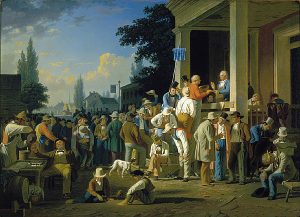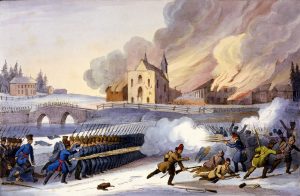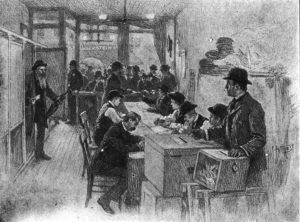2.1 Historical Voting Practices
Expressing electoral preferences has taken many forms over the centuries: using corn and beans; lining up on opposite sides of a road, or even shouting your vote in public. Voters in Medieval Venice used little metal balls, called ballottas, to cast votes, which likely inspired the term we use today (Mayton & Reno, 2021). The process of casting votes has undergone many changes before producing the paper ballots we recognize today.

Brawls, Booze, and Ballots
Prior to the 19th century, elections throughout Europe and North America didn’t even use ballots. Rather, voters indicated their preferences verbally while a clerk or scribe tallied the choices. This practice of voice voting was known as Viva voce. As you might imagine, announcing votes publicly presented challenges.
For one, intimidation was rampant. The Canadian Museum for Human Rights describes the atmosphere as one of “brawls, booze, and ballots” where bribery and intimidation were rampant (McRae, 2019). Elections Canada estimates that at least 20 Canadians lost their lives due to voting-related violence (Elections Canada, 2021), although comprehensive official statistics aren’t available. Violence and intimidation weren’t the only problems. Early Canadian elections involved a process known as treating, which was a name given to offering food, drink, and even cash in exchange for votes (McRae, 2019).

Aside from the potential for corruption, voice voting has a weakness of scale. It might work in smaller rural communities where the population might have a few dozen eligible voters, but it becomes unworkable as populations grow. As industrialization and urbanization pulled people closer together, new systems for casting votes evolved. By the 18th century, paper ballots became more common.
Paper Ballots
Early paper ballots weren’t much better. At times, voters were encouraged to prepare and use their own ballots. It was also common for newspapers or political parties to create a ballot for their preferred candidates called a ticket. These ballots sometimes doubled as a source of party propaganda and disparagement (Cheng, 2020). In 1858, the Australian government acted to bring consistency to the chaos of election voting by printing uniform ballots at the expense of the state. (Mayton & Reno, 2021). The measure incorporated two important innovations. For one, the government would produce standardized lists of candidates, and second, the ballots would be marked in private (Cheng, 2020). This practice of casting a paper ballot in secret became known as the Australian Ballot.
The Australian Ballot

This ‘Kangaroo Vote’ or ‘Australian Secret Ballot’ eventually made its way to North America. New Brunswick was the first Canadian province to use a secret ballot in 1855 (Marsh, 2009), with a federal implementation in 1874 (Elections Canada, 2021). The first use of a secret paper ballot in America was in Louisville, Kentucky, in 1885, yet it was opposed by “machine politicians” who were probably happy with the existing system of bribery & intimidation (Keyssar, 2000).
Resistance was common. In 1892, voters in one West Virginia precinct demolished a polling station in protest of using the secret ballot (Wiggins, 2020). While the problem of intimidation was indeed reduced, the elimination of voice voting posed new challenges for an electorate that lacked widespread literacy. The adoption of paper ballots meant voters now needed to decipher complex written instructions and confusing ballot designs.

